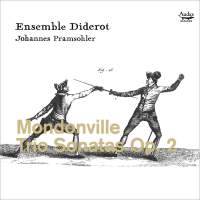Texte paru dans: / Appeared in: |
|
|
Outil de traduction ~ (Très approximatif) |
|
|
Reviewer: Barry
Brenesal The extent to which Jean-Joseph de Mondonville (c. 1711–1772) proved a lightning rod to attacks during the Querelle des bouffons can only be understood today by establishing some context. Imagine a culture where the debate between French and Italian music assumed international proportions, and acted as a focal point for political, social, and cultural conflicts among a host of committed parties, and you’ll have some idea of why so much passion and ink was spilled over the issue. Like other French composers in the first half of the 18th century, Mondonville achieved his own version of les goûts-réunis. His problem was that as time passed, the Italian side in the argument concluded that it had won, and Mondonville, a favored composer in some noble circles, intendant of the Royal Chapel, head of the Concert Spirituel, refused to change and compose as its adherents dictated. This led to his being alternately praised and vilified loudly by critics, sometimes the same ones, based on a strict accounting of style in any given work.
Going back to 1734 and the publication of the Trio Sonatas heard on this album reveals in almost schematic fashion just how polarized and polarizing Mondonville’s approach to French and Italian musical reconciliation was. All but one of these four-movement trio sonatas follow the da chiesa plan made popular by Corelli, with moderately academic fugues in second place, and fast, witty finales utilizing quicksilver imitative textures. These movements are without exception as Italianate as at least some of the 18th-century polemicists on such matters: virtuosic, incorporating moments of dissonance, and great rhythmic drive. The other two movements, by contrast, are slow, sensitive, chamber-like, meant to entertain by touching the senses, rather than shocking them—in a word, French, with harmonic patterns and dance steps imported from the French countryside and familiar to audiences of his day from the operas of Campra and Rameau.
The “aria” from the First Sonata in E Minor and the “gratios” from the Second Sonata in E♭ Major are excellent examples of Mondonville in this latter vein, which would increasingly draw the invective of Rousseau, Diderot, and the Encyclopedists over the years. But to us today, divorced from all concern over the violent rhetoric and the parties involved, there remain the trio sonatas themselves. They are fresh, clever, and engaging. The part-writing is exceptionally active—which is not surprising, given that the composer was taught by his father, who was organist at Maîtrise de St. Just in Narbonne. In three of the sonatas Mondonville approved the optional use of a pair of violins or flutes, as Edith Borroff noted in her article on the composer in Grove I. Ensemble Diderot follows up this suggestion in two of those sonatas here, the Third and Fifth, replacing the second violin part (which has no double-stops) with a flute to fine textural effect. If neither fast nor slow, Italian nor French movements impress with a unique musical personality, that wasn’t an issue which mattered at the time. What mattered were skill, style, and expressiveness. These trio sonatas meet all three requirements with an ample display of wit and charm. Ensemble Diderot consists of five musicians on this release, led by violinist Johannes Pramsohler. They are technically expert, as I noted in a previous release of violin concertos by Antonio Montanari, and handle the complex interweaving of violin duo (or alternatively, violin and flute) textures in particular with élan. Unlike that Montanari album, which rushed tempos in its adagio movements, they allow slow movements here to play out at reasonable tempos, and ornament discreetly. Vibrato is used only as a coloring device, but instrumental tone never ceases to be attractive—even in the relatively close, tonally rich recording environment employed here. Phrasing is good, too, and fast movements have the kind of energy and flowing precision that reminds me of Il Giardino Armonico. With such music, performed and recorded so well, giving a positive recommendation becomes a pleasure. | |
|
Support us financially by purchasing this disc from eiher one of these suppliers. Un achat via l'un ou l'autre des fournisseurs proposés contribue à défrayer les coûts d'exploitation de ce site. |
|
|
|
|
|
Cliquez l'un ou l'autre
bouton pour découvrir bien d'autres critiques de CD |
|




